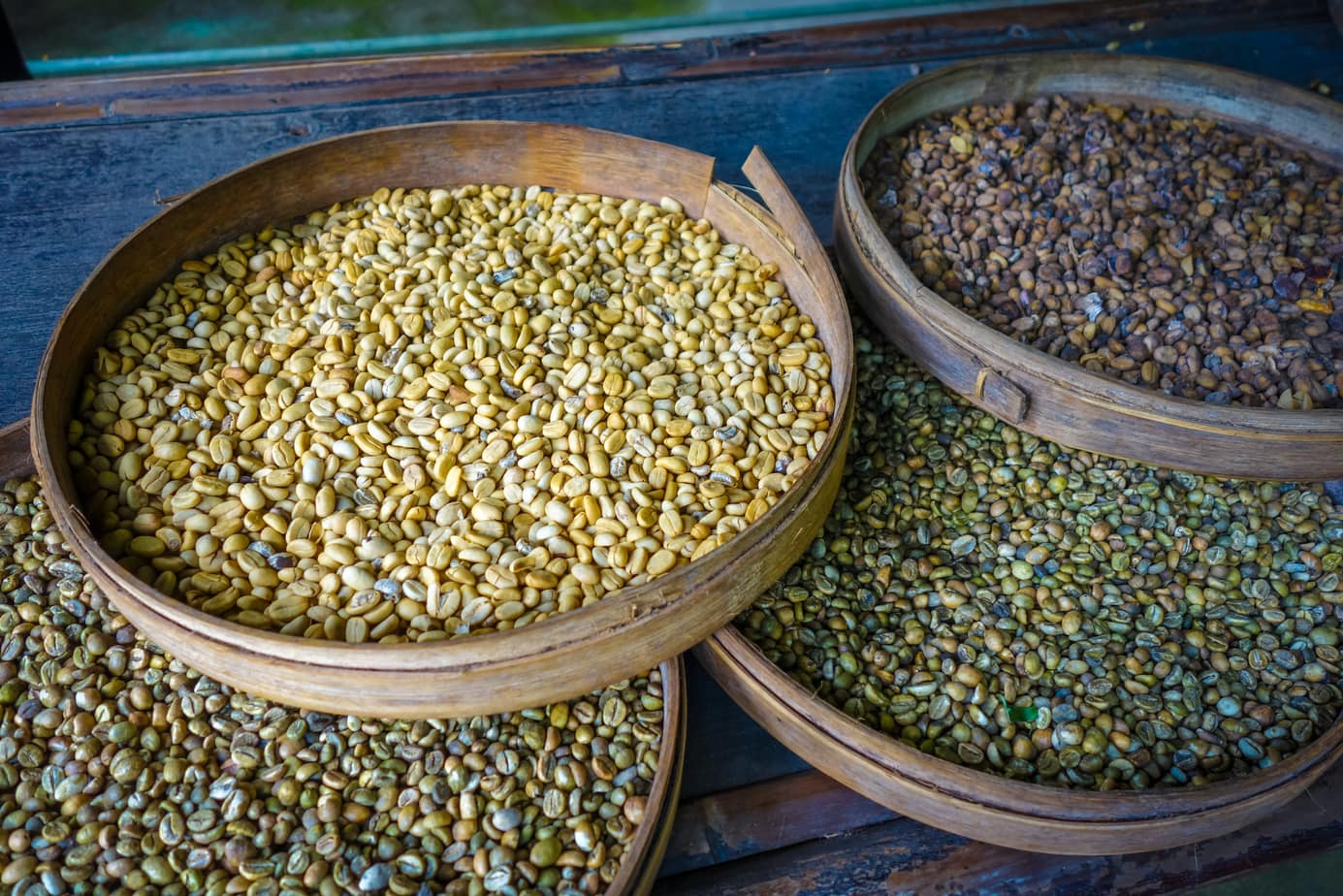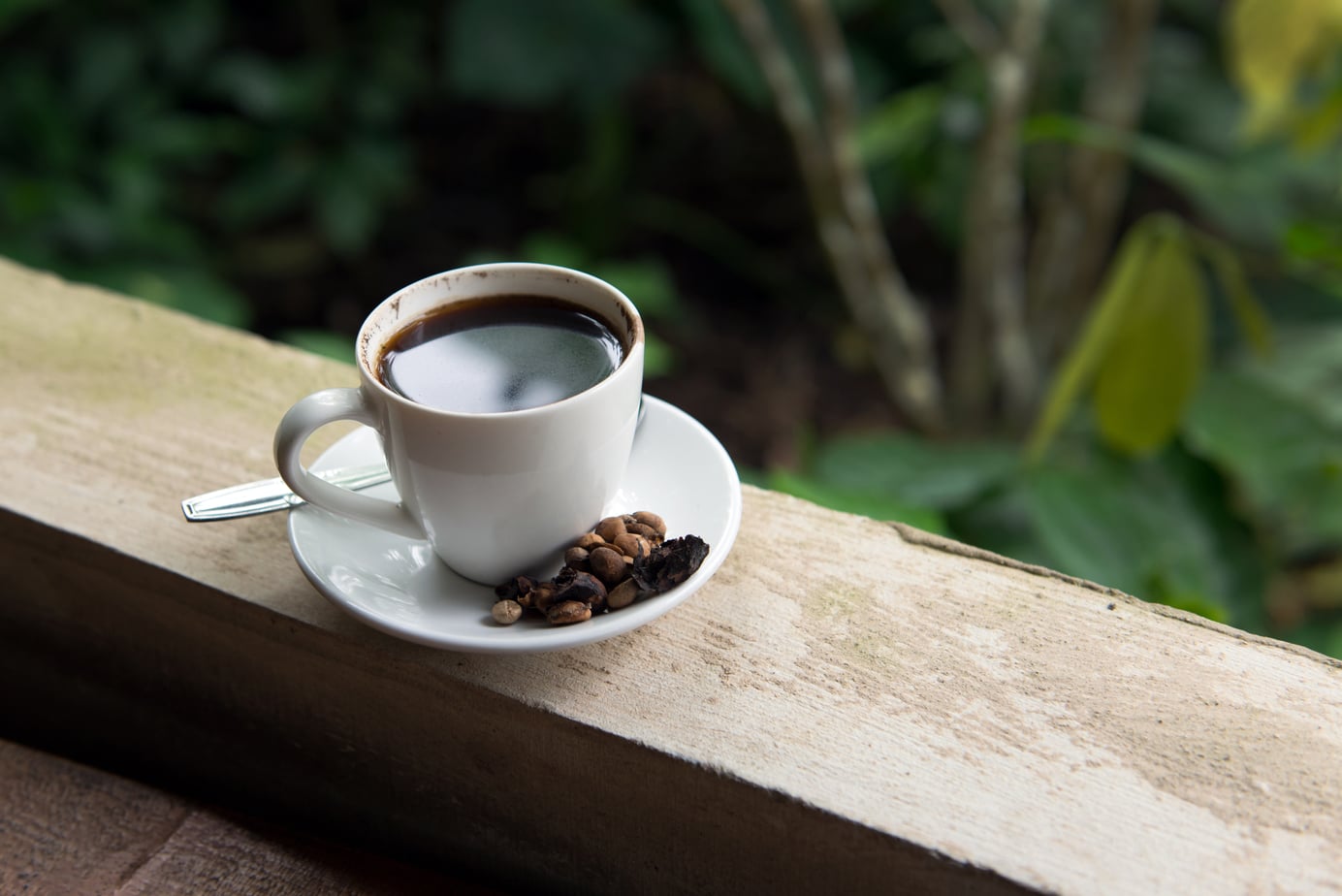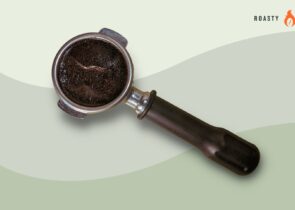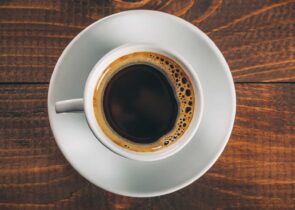The beautiful island of Bali in Indonesia is known for its volcanic mountains, beaches, and coral reefs – what more can you ask of an adventure into paradise? Well, we can think of one more thing: coffee.
What could be better than starting your day sipping on uniquely brewed and locally-harvested coffee before tackling some of the island’s main attractions? Luckily for us, Bali has a variety of one of a kind coffees to enjoy, and a strong cafe culture that means it is both accessible and affordable.
What types of coffee can be found here? And what’s the deal with the famous Kopi Luwak coffee? Why is it so expensive? Let’s find out.
How Did Coffee Come to Bali?
Coffee was introduced to the majority of Indonesia by the Dutch quite early on in coffee history. As a result, many of Indonesia’s coffees have Dutch roots. Bali, however, is an exception: Balinese coffee originated with Lombok traders who began establishing coffee plantations in Bali in the early 20th century.
Indonesian coffees are regarded to be some of the best in the world and are described as having strong woody and earthy flavors. Despite having different roots, Balinese coffee is no exception.
Bali’s soil is rich with nutrients from its volcanic mountains, and many coffee farmers in Bali grow their coffee beans alongside citrus fruits which gives the coffee a unique fruity flavor.
Notably, there are two distinct types of coffee in Bali. The first is roast coffee, and while Bali’s roast coffees are unlike any other, there is a more famous variant of Balinese coffee: Kopi Luwak, also known as “cat poop coffee”.
Roast Coffee
Bali’s primary coffee-growing region is the Kintamani region, located in the northeast. These coffee plantations sit atop a large volcanic plateau which makes the region’s soil extremely rich. Traditionally, coffee crops in Kintamani are Robusta but Arabica is becoming more widespread as a result of its higher selling price in world markets.
Arabica
Arabica beans generally have a sweet, soft taste with tones of sugar and fruit which complement the Balinese coffee’s citrus notes. It is believed to be one of the first species of coffee to be cultivated, and contain almost 60% more lipids and twice the amount of sugar that Robusta contains.
The sugar content of Arabica means the coffee is less bitter and has a cleaner texture. These desirable attributes are why Bali coffee is increasingly focusing on Arabica coffee plants.
Robusta
On the other hand, Robusta is stronger and more grainy with a distinctive nutty aftertaste. In comparison to Arabica, however, it contains more of the antioxidants that are responsible for some of the coffee’s health benefits.
Additionally, for those who need a strong pick me up in the morning, Robusta has on average 83% more caffeine than Arabica.
Robusta coffee is often found in instant coffee which gives it a bad rap, but when you find high-quality Robusta beans they can have a gritty, full-bodied taste.
Overall, the complexity of Bali coffee is usually best suited for a medium roast. The taste of Balinese coffee is sometimes compared to Papua New Guinea coffees and is highly valued in Japan.

Kopi Luwak
Kopi Luwak is a famous Bali coffee because of how it’s produced. When the Dutch colonized Indonesia, they heavily prohibited locals from consuming coffee, therefore making it a highly sought after commodity.
Then, locals began to notice that a native species of palm civet, the Luwak, would eat coffee cherries from the plantations during the night. After eating, the Luwak would then drop partially digested coffee cherries in their feces.
These cherries would then be cleaned, roasted and ground for personal use. Historically, the process was very time consuming, as people had to go and harvest wild Luwak droppings. Unfortunately, now that Luwak coffee is in higher demand, there has been an increase in the animals being held in captivity to harvest their droppings.
What’s the Big Deal?
The rationale of why anyone would want to consume a cup of cat coffee poop is questionable to some. However, Kopi Luwak is regarded as having the richest taste of any coffee. The enzymes in the civet’s stomach cause the coffee beans to be less bitter, so while the coffee stays incredibly rich, the flavor itself is quite mild.
Coffee from Indonesia is already very popular for producing some of the best brews in the world, but Luwak coffee sets itself apart as a result of its unusual source.
Is It Safe To Drink?
Upon hearing that your coffee beans were refined out of Luwak poop, the first thing that comes to mind is the question of whether or not it’s safe to drink. No matter how good the coffee may taste, it’s not worth getting food poisoning over.
Fortunately, the Kopi Luwak coffee making process eliminates any harmful germs that may get into your cup. The washing and roasting of the coffee beans ensure that there will be no contamination from E. Coli or other bacteria.
Is It Expensive?
Kopi Luwak’s high profile attributes and unique origin contribute to it being regarded as the most expensive coffee in the world. A cup of “coffee cat poop” can set you back $335 to $80 (USD) depending on authenticity. By the pound, Kopi Luwak prices range between $100 to $600.
There is a lot of range in the market for Kopi Luwak as a result of various business practices. Traditionally processed Luwak coffee takes a long time to harvest because you have to search for Luwak feces, but recently farmers hoping to make quick money have started trapping wild civets and caging them to make production faster.

Controversy
As a result of Kopi Luwak’s popularity, farmers around Indonesia have been capitalizing upon the opportunity to make money. To speed the process up, some farmers are trapping and caging civets so that Luwak feces aren’t difficult to obtain. This inhumane treatment means that the animals are held in captivity in horrid conditions.
Some producers of Kopi Luwak also don’t supplement the Luwak’s diet with anything but coffee beans: the rationale is that the less other food the civets eat, the more coffee beans they will produce. The animals often die of malnutrition while in captivity or otherwise die from unsanitary living conditions
At the same time, experts say that this destroys the coffee’s unique quality since the main rationale behind it is that the civets roam the wild and pick and choose the best coffee cherries. If they’re just fed ANY cherries, this destroys the whole uniqueness of Kopi Luwak coffee.
There are also some controversial opinions that Kopi Luwak is not that good even to begin with. As quoted in the Specialty Coffee Association of America, the trade organization for gourmet coffee roasters and baristas, the civets’ digestion makes the coffee smoother, it also removes most of the acidity and flavor that one is looking for in a cup of specialty coffee.
What To Look For In Balinese Coffee
Beware of Scam Products
It is vitally important to pay attention to where you are sourcing your Kopi Luwak coffee. Many farmers are using inhumane methods and caging wild animals, and it is important not to support cruel battery farms.
Additionally, schemers looking for a quick buck have also realized that something even easier than farming Luwak feces is just buying regular coffee beans and passing them off as a high-quality product. According to some studies, up to 80% of all Kopi Luwak sold is fake.
Unfortunately, there aren’t many clear cut ways to determine where your coffee was sourced and produced. The Sustainable Agriculture Network (SAN) and some other established coffee certifiers issue their stamp of approval on certified, ethically-produced coffees, but there isn’t a large range of certified products available and not all products on the market are legitimized.
If you are going to buy some Kopi Luwak, make sure you do your research and look for certification stamps from well-known certifiers.
Wet-Processing
Yet another characteristic of Bali coffee that differs in comparison to other coffees in Indonesia is how it is processed. While there are dry-processed coffee beans available, the majority of Bali coffee is wet-processed. Wet-processing is a traditional way of coffee processing in Bali.
Wet-processing entails removing the fruit covering the coffee bean before they are dried, as opposed to dry-processing where the entire coffee cherry is dried at once. Wet-processed coffee has a brighter, fruitier taste than dry-processed coffee which helps the fruity tones of Bali coffee pop.
If you’re going to invest in a cup of Bali coffee, you might as well take the full plunge and try wet-processed.
Shop Bali Coffee
Bali Blue Moon Coffee
This fresh roast is creamy and has bold dark chocolate and vanilla bean notes. It is 100% Arabica and while Indoenisa’s earthy tones are toned back in this brew, you can still experience the trademark richness of coffee grown on Kintamani soil. It is also organic and ethically sourced.
Happy caffeinating!








